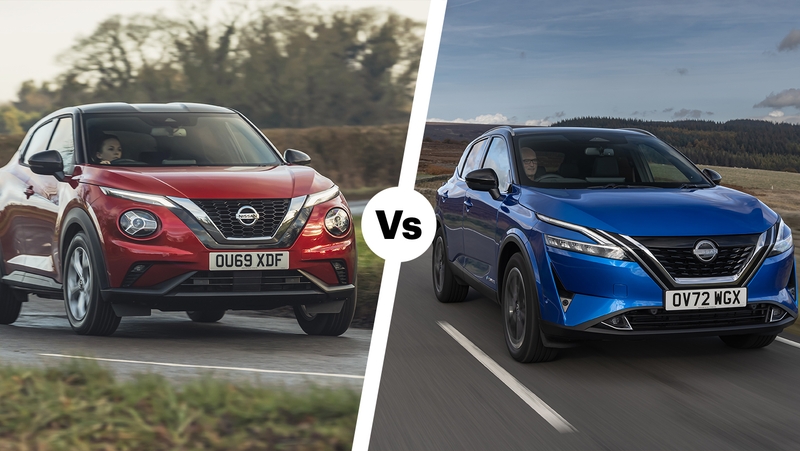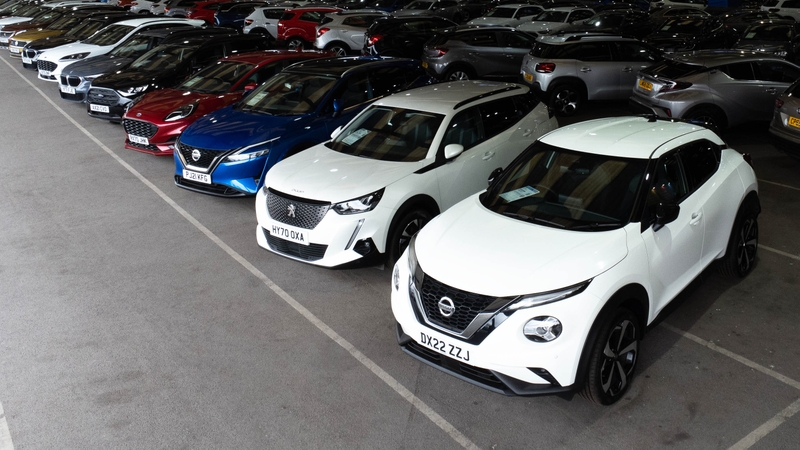
Nissan Juke interior, tech and practicality
Gallery
Comfort and visibility
With faux-leather dashboard trim, shiny air vent surrounds and carbon-effect trim around the instrument cluster, the Juke’s interior looks premium. The actual feel of some of the materials, such as the plastics around the air vents and on the lower centre console, isn’t so impressive, and nor is the slightly plasticky feel of the steering wheel.
Everything does at least feel well constructed. Nothing is likely to fall off and you shouldn’t hear any creaks in a nearly new Juke. The buttons and dials, of which there are a few, feel solid and are very easy to use while driving. Unlike cars that are more reliant on touchscreen controls, like the Citroen C3 Aircross, you can adjust the Juke’s controls without taking your eyes off the road as much.
You sit nice and high in the Juke – you certainly feel further from the ground than in the Skoda Kamiq or Kia Stonic. This driving position helps you see ahead, so forward visibility is good. However, the Juke’s sleek shape means that rear visibility isn’t much to write home about. We’d recommend going for at least Acenta trim because this has a reversing camera to make parking easier.
Nissan focused on the interior in the 2024 facelift, and our gripes with earlier cars are almost all fixed. The steering wheel – arguably the most important touchpoint – now feels more like leather, while the new N-Sport trim adds recycled Alcantara suede to the dashboard. This goes surprisingly far to make the Juke feel more premium.
Standard equipment
Entry-level Visia trim does well for safety equipment, with auto emergency braking, auto high-beam headlights, lane-departure warning, traffic sign recognition and hill-start assist all coming as standard. You also get DAB radio and basic Bluetooth capabilities, plus all-round electric windows and manual air conditioning. Finally, there are bright LED headlights to help you see at night, and cruise control for keeping at a set speed.
Acenta not only swaps the Visia’s plastic wheel covers for proper alloys, but also has a touchscreen in place of the basic radio display you get in the lesser trim. This is home to smartphone mirroring and the display for the aforementioned reversing camera. These additions make the Acenta feel a much more modern car than the Visia.
N-Connecta also has 17-inch alloy wheels but in a different design. You also get sat nav included in the infotainment system, a semi-digital instrument display and push-button start. There’s also an electric handbrake with auto hold, and the air conditioning is upgraded to automatic climate control.
Next up is Tekna trim, which is pretty much top-spec. This gets 19-inch diamond-cut alloys, ambient interior lighting and Nissan’s Heat Pack with heated front seats, a heated windscreen and a heated steering wheel. Active safety tech also gets a boost, with a 360-degree parking camera, blind-spot monitoring, lane-keep assist, adaptive cruise control and rear cross-traffic alert all fitted. Audiophiles will no doubt love the upgraded Bose sound system, complete with speakers in the front-seat headrests. Top-top-spec Tekna+ largely adds aesthetic upgrades inside and out.
The new-for-2024 N-Sport trim is marked out by a yellow boomerang-shaped interior insert and a black roof. It’s the same price as the Tekna+. We’re disappointed that the good-value Visia and Acenta trims have been dropped in the update.
Infotainment and audio
It’s a good job that Apple CarPlay and Android Auto are included on all versions with a touchscreen, because Nissan’s own system isn’t quite up there with the best in class. There are many of the features you’d expect in a modern, youthful car, like WiFi connectivity, but the graphics look outdated and it could be quicker to respond.
In some lights and situations, you’ll experience quite a bit of glare from the screen – in bright light, this can render the screen unreadable. Nissan has since fitted the newer Qashqai with a larger, more premium-looking screen, and we’re glad this screen has now become available in new Jukes – even if it’ll be a little while before these big-screened Jukes make it to our stores.
Rear seat space
In the old Juke you might’ve considered chopping your legs off to be comfortable in the back seats. Thankfully, you don’t need to take any drastic action in the latest Juke which, despite its sleek shape, is more than roomy enough for adults in the back seats. Both legroom and headroom is good, and two six-foot adults shouldn’t have any issues sitting beside each other or one behind the other.
You’ll just have to watch your head when you get in and out, because of the car’s sloping roof. This is just like the best-selling Ford Puma, though, so it’s obviously not a major issue for many buyers. In the Juke, you can just about sit three adults across the back row, and the middle-seat occupant should have just enough legroom as the transmission tunnel is fairly small.
The Juke’s ‘hidden’ rear door handles might also take some getting used to but, once the doors are open, there’s plenty of room to get kids in and out. The Isofix points are easily accessible and there’s a 12V socket to charge devices – just remember to pack a USB adaptor.
You also get seat pockets and pretty big door bins, but you don’t get any of the nice-feeling materials that are fitted in the front. Without any rear air vents, it can get hot in the rear seats as well.
Boot space
With the adjustable boot floor in place, there’s not an awful lot of cargo room. Unless you don’t want a load lip or want a flat floor when the rear seats are folded, we’d keep the false floor in its lowest position or just throw it in the shed and forget about it. Do that and you have a very competitive 422-litre boot, which is marginally more than the SEAT Arona, Volkswagen Golf and Toyota C-HR. The hybrid has a few litres less than the petrol engine, but you’re not going to notice the difference.
Fold the rear seats down and you get about 1,300 litres to fill which, again, is on a par with some of the roomier small SUVs.




















































